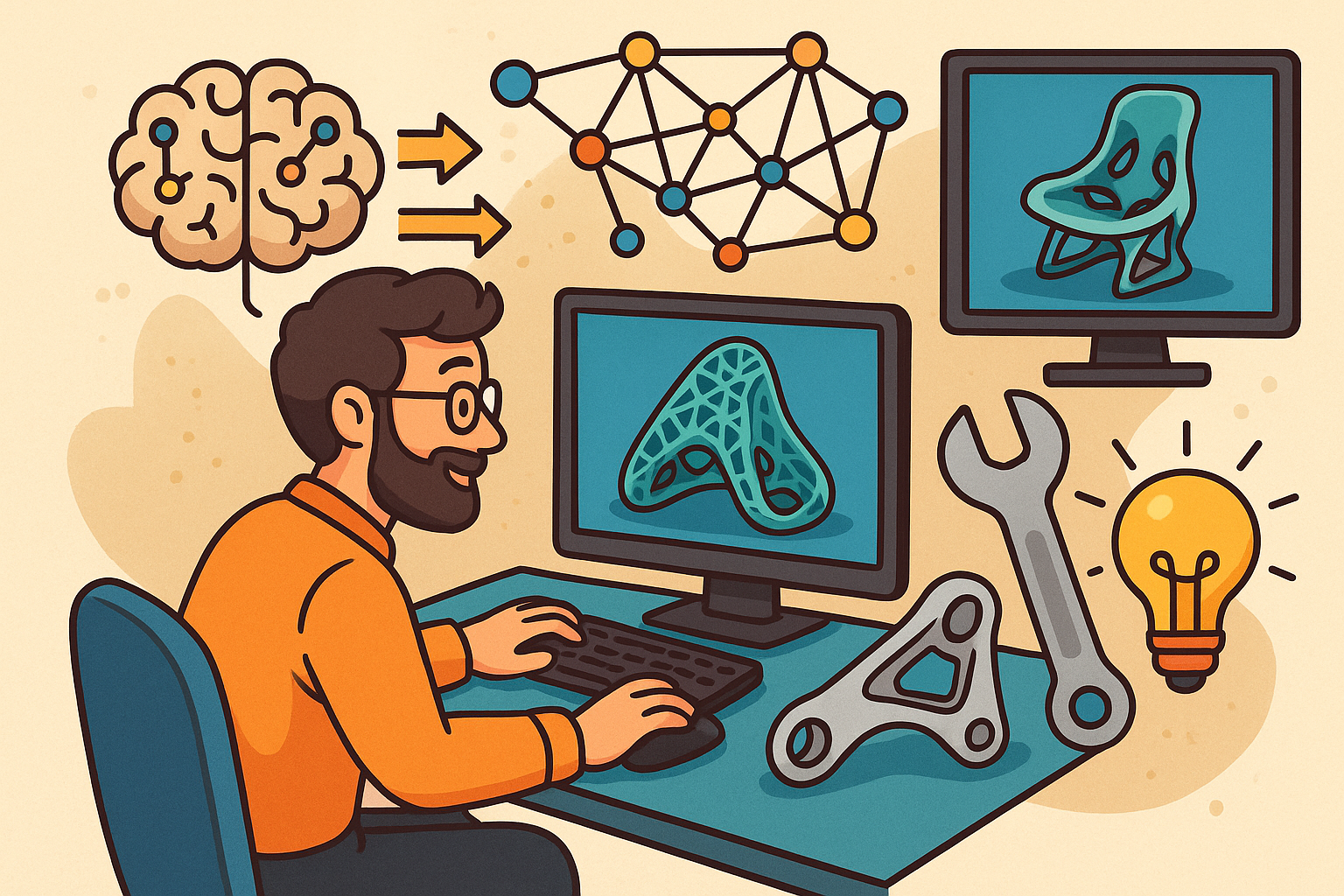Your Cart is Empty
Customer Testimonials
-
"Great customer service. The folks at Novedge were super helpful in navigating a somewhat complicated order including software upgrades and serial numbers in various stages of inactivity. They were friendly and helpful throughout the process.."
Ruben Ruckmark
"Quick & very helpful. We have been using Novedge for years and are very happy with their quick service when we need to make a purchase and excellent support resolving any issues."
Will Woodson
"Scott is the best. He reminds me about subscriptions dates, guides me in the correct direction for updates. He always responds promptly to me. He is literally the reason I continue to work with Novedge and will do so in the future."
Edward Mchugh
"Calvin Lok is “the man”. After my purchase of Sketchup 2021, he called me and provided step-by-step instructions to ease me through difficulties I was having with the setup of my new software."
Mike Borzage
Generative Design's Role in Revolutionizing Product Development
May 20, 2025 9 min read


Introduction to Generative Design in Product Development
Generative design represents a paradigm shift in modern product development, introducing a revolutionary process where designers leverage advanced computer algorithms to explore thousands of design solutions. At its core, generative design uses mathematical models, simulation techniques, and iterative testing to automatically generate a suite of design options based on defined performance criteria and constraints. This approach ensures that products meet the rigorous demands of efficiency, aesthetics, and functionality in industries ranging from consumer electronics to aerospace and automotive sectors. Unlike traditional design methodologies that rely on manual drafting and incremental modifications, generative design builds on decades of evolution in design software where innovation is propelled by the marriage of computational power and creative insight. The historical progression of these methods has seen a gradual shift from hand-drawn concepts to the adoption of computer-aided design (CAD) systems, culminating in today's algorithm-driven processes that can seamlessly extract and process large volumes of data. Over the years, the design community has witnessed the transformation from static design documents to highly interactive, simulation-rich environments where ideas are iterated at speeds previously unimaginable.
Evolution from Manual Drafting to Algorithm-Driven Innovation
The journey of design innovation has been marked by significant milestones, starting from the era of manual drafting where engineers relied on physical blueprints and sketches. These early methods, while artistic, were often constrained by human limitations in accuracy and scalability. With the advent of computer-aided design tools, the landscape began to change, introducing systematic approaches that allowed for precise modeling and simulation of real-world scenarios. Over time, the integration of algorithm-driven methodologies into the design process has further accelerated this transformation. Modern generative design tools not only simulate physics-based environments but also dynamically adjust design parameters to create diverse iterations that meet specific performance metrics. This new era of digital design empowers engineers and creative professionals alike to venture into complex design spaces where traditional techniques would have fallen short, harnessing computational intelligence to guide decisions, reduce human error, and ultimately create optimized products. Key industry players now rely on these advanced technologies to push the boundaries of what is possible, ensuring that every design is informed by data, best practices, and innovative exploration.
Importance within the Broader Landscape of Design Software Tools
In the broader context of modern design software, generative design serves as a critical enabler of innovation and efficiency. It is not merely a tool for automating repetitive tasks but a comprehensive platform that integrates deep analytical processes with creative exploration. Within any product development lifecycle, the iterative design process is vital for refining ideas and ensuring that the end product performs under real-world conditions. Today’s design software ecosystem incorporates generative design to work in tandem with traditional CAD programs, simulation packages, and material property analysis tools. This integration facilitates a more holistic approach where multiple aspects of product development—from initial concept to final validation—are interconnected. Enhanced by the ability to synthesize data from experiments, simulation outcomes, and even market trends, these generative workflows empower engineers to craft solutions that are not only innovative but also practical and production-ready. As a result, the value of generative design is increasingly recognized across disciplines, leading to faster prototyping cycles, reduced development costs, and an overall boost in competitive advantage for companies adopting these state-of-the-art methodologies.
Core Technologies, Principles, and Workflows
Modern generative design relies on a multifaceted technological framework that combines sophisticated algorithms, optimization techniques, and simulation tools. At the heart of these systems lies a set of key principles: defining design parameters, establishing constraints, and harnessing computational intelligence to iterate through potential solutions. One of the most influential aspects is the integration of artificial intelligence (AI) and machine learning algorithms that enable platforms to explore numerous design scenarios. By analyzing vast datasets, these systems can predict outcomes, optimize for performance, and even evolve design concepts dynamically. In practice, the process involves feeding the design software with criteria such as mechanical stress, thermal performance, material limitations, and aesthetic guidelines. Once these inputs are established, the software employs a series of simulation and optimization cycles that allow it to test, discard, or refine each potential design iteration. The result is a robust workflow that not only speeds up the design process but also significantly enhances product performance and innovation.
Key Algorithms and Optimization Techniques
In exploring the vast landscape of potential design iterations, several core algorithms and optimization techniques play pivotal roles. Systems deploy algorithms that leverage evolutionary computing, parameter sweep methodologies, and gradient descent optimization to converge on the best design configurations. These computational strategies are bolstered by AI and machine learning, which analyze previous simulations and outcomes to predict design feasibility and performance. Underpinning these methods is the integration of physics-based simulations—tools that compute material properties, mechanical stresses, and environmental impacts—to validate each design option in real-world conditions. In addition to these computational methods, designers frequently employ bullet-pointed frameworks to outline essential steps and considerations:
- Use of AI and Machine Learning: Multiple iterations analyzed and refined based on predictive algorithms.
- Physics-Based Simulations: Ensuring that designs adhere to realistic material properties and performance expectations.
- Optimization Cycles: Iterative processes that narrow down design options based on predefined constraints.
- Automated Iterative Testing: Computational methods that rapidly test, validate, and improve designs.
Design Parameters and Automation in Iterative Process
A critical component of generative design workflows is the precise definition of design parameters and constraints that guide the iterative process. From a practical perspective, these parameters often include dimensions, material properties, load-bearing capacities, and environmental factors, all meticulously defined to ensure consistency and reliability. The automation inherent in modern design software allows for rapid adjustments based on feedback from each iteration. For instance, if a specific design fails to meet the thermal performance criteria or exhibits potential structural weaknesses, the system automatically refines the parameters to produce improved alternatives. This tightly coupled feedback loop between simulation, evaluation, and iteration ensures that each revised model better meets both the aesthetic and functional requirements set forth in the design brief. As a result, companies are able to drastically reduce development time while simultaneously bolstering the quality of the final product. The benefits of this automated, iterative approach are clearly evident in the seamless integration of computer-driven decision-making into the design process—a true hallmark of modern engineering and creative practice.
Real-World Applications and Impact on Product Development
The transformative effects of generative design are evident in the way it redefines product development across a spectrum of industries. In environments where performance, efficiency, and innovative aesthetics are paramount, generative design plays a crucial role in mitigating traditional limitations associated with manual design processes. Industries such as automotive, aerospace, and consumer products have embraced these methodologies, resulting in significant reductions in development cycles and enhanced product performance. The process enables engineers to harness the power of advanced simulation and optimization techniques, generating a multitude of design solutions tailored to specific performance metrics. Furthermore, generative design has been seamlessly integrated with visualization techniques that enhance product rendering and prototyping, particularly when paired with additive manufacturing technologies. The end-to-end workflow, from computational design to physical prototyping, opens up unprecedented avenues for creative exploration and engineering optimization. With the aid of advanced simulation tools, designers are now able to create products that not only meet stringent regulatory standards but also emerge as frontrunners in aesthetics and functionality, effectively setting new benchmarks for innovation.
Industrial Advantages and Performance Optimization
In practical application, the benefits derived from generative design can be summarized in numerous ways. One of the most notable is the reduction in development time, significantly shortening the path from concept to market. Enhanced performance characteristics have been achieved through data-driven refinements and the rapid identification of design flaws that traditional methods might overlook. This paradigm shift is underpinned by the integration of robust analytical tools that allow engineers to simultaneously optimize multiple aspects of a design, leading to products that are lighter, more efficient, and aesthetically appealing. Among the major advantages, one can list several key points:
- Reduced Development Time: Streamlined workflows that enable faster iterations and quicker market adaptation.
- Optimized Performance: Advanced simulation tools provide precise testing and iterative refinements to ensure design integrity.
- Innovative Aesthetics: The ability to generate unconventional design forms that push the boundaries of traditional engineering.
- Enhanced Integration: Seamless interconnection with additive manufacturing facilitates rapid prototyping and real-world testing.
Visualization and Integration with Additive Manufacturing
A key element that accentuates the impact of generative design in today's product development is its integration with state-of-the-art visualization techniques and additive manufacturing processes. Complex 3D models generated through algorithmic exploration are enhanced using sophisticated rendering methods, making it easier for designers to visualize intricate details and subtle nuances. This convergence of digital design and physical prototyping not only facilitates faster iterations but also provides designers with tangible artifacts that can be tested in real-world conditions. The advent of additive manufacturing has further accelerated these benefits by enabling prototype production with minimal lead times. By merging the computational power of generative design with advanced 3D printing technologies, companies are empowered to produce highly optimized products that are both functional and visually unique. Such advances represent a clear departure from conventional prototype production methods, where trial and error often meant lengthy turnaround times and substantial costs. The synergistic integration of these tools paints a vivid picture of modern engineering’s capacity to marry form with function in unprecedented ways.
Challenges, Future Trends, and Conclusion
Despite its remarkable benefits, generative design faces several challenges that must be overcome to fully harness its potential in the realm of product development. One of the primary concerns is the substantial computational demand required to execute complex simulations and iterate through extensive design possibilities effectively. Modern design software must juggle large-scale simulations while ensuring that the analysis remains both timely and accurate. Additionally, as the complexity of design parameters increases, integrating diverse datasets—ranging from material properties and environmental conditions to user-specific requirements—can introduce further challenges in terms of data management and processing. A critical issue is striking a balance between automation and human creativity. While generative design offers incredible advantages by automating redundant tasks and iteratively refining models, the role of human intuition remains indispensable in making final design decisions. Another challenge is ensuring that the design outputs are not only theoretically optimized but also practically feasible when transitioning from digital models to physical products. Issues such as manufacturability, cost-effectiveness, and regulatory compliance must all be considered during the final stages of design development.
Current Challenges and Computational Demands
The intricate nature of modern design software means that managing large-scale simulations can place significant pressure on both hardware and software infrastructures. High-performance computing resources are often required to process the vast amounts of data generated during the iterative cycles of generative design. As models become more detailed and constraints more stringent, the need for efficient data integration frameworks grows ever more critical. Furthermore, while automation and AI-based decision-making can accelerate initial design phases, expert oversight is essential to interpret the results and ensure they meet practical requirements. In many instances, the juxtaposition of automated outputs with human judgment enables designers to discard unfeasible options early on, focusing on solutions that align with manufacturing realities and strategic business objectives. This balancing act is a topic of ongoing research and debate within the industry, as designers and engineers continually attempt to optimize both the efficiency of computational processes and the reliability of the final product.
Future Trends and Final Reflections on Generative Design
Looking ahead, several compelling trends are poised to shape the future of generative design. Among these trends is the enhanced integration with collaborative platforms that allow design teams to work seamlessly across different geographical locations and disciplines. Advances in real-time simulation technologies are also expected to reduce turnaround times appreciably—allowing iterative cycles to be completed almost instantaneously. Emerging hardware accelerators, such as specialized processing units and cloud-based computation services, promise to ease the computational burden significantly, opening the door for even more complex and precise design iterations. Moreover, as generative design tools continue to evolve, they will likely become more accessible to a broader range of industries, democratizing the benefits of algorithm-driven innovation. In conclusion, the transformative potential of generative design lies in its ability to unlock a nearly infinite realm of product development possibilities. By combining advanced simulation, machine learning, and additive manufacturing technologies, the design process is moving towards a future where efficiency, innovation, and creativity coexist harmoniously. Although challenges such as high computational demands and the need to balance automation with human insight remain, the ongoing evolution of these tools signifies a promising shift. The future of product development will undoubtedly witness enhanced integration between digital workflows and physical production, affirming the pivotal role that modern design software plays in shaping a more innovative and dynamic world.
Also in Design News

Cinema 4D Tip: Efficient Lookdev Iteration Using Cinema 4D Picture Viewer History
January 01, 2026 2 min read
Read More
Revit Tip: Standardized Revit Export for Reliable Navisworks Clash Detection
January 01, 2026 2 min read
Read More
V-Ray Tip: VRayOverrideMtl Clay Pass for Accurate Lighting Evaluation
January 01, 2026 2 min read
Read MoreSubscribe
Sign up to get the latest on sales, new releases and more …


